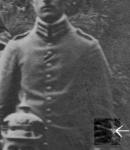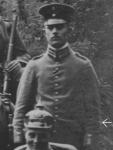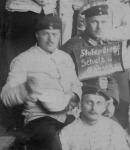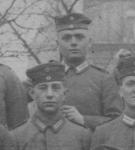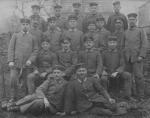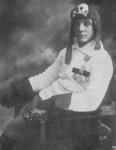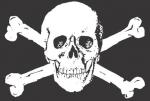
Thomas W
For Deletion-
Posts
788 -
Joined
-
Last visited
-
Days Won
3
Everything posted by Thomas W
-
According to Steven J. Zaloga, German Panzers 1914-1918: Osprey New Vanguard 127 (Oxford: Osprey Publishing, 2006), p. 37, that's Tank No. 504 "Schnuck." The photo was taken in the summer of 1918, when Abteilung 2 was conducting a demonstration. The officer on the left is Lt. Albert Müller. Tank 504 was fired on by German artillery at Frémicourt on August 31, 1918. Although the shells did not penetrate, the crew abandoned her and she was captured intact by the British and eventually scrapped.
-
Here you go, Sergeant 08. Doppelklief M.1915, late model. Two late-model Kleif M.1915 connected by a 1.5m hose and a 3m hose to a telescoping Grosse Strahlrohr M.1914, which was 1.75m long when extended. The Doppelkleiftrupp was usually made up of seven men: Lance operator (Strahlrohrführer), assistant (Hilfsmann), first Kleif carrier (Kleifträger), assistant, second Kleif carrier, assistant, and squad leader (Truppführer). The Doppelkleif was used in shell holes and saps to cover the advance of small-flamethrower squads, and it was used in trenches to overcome barricades.
-
Robin, the 1st Company of the Reichswehr formation (Preussisches) Pionier-Bataillon Nr. 3, garrisoned in Küstrin, was the Traditions Unit of the Garde-Pionier-Bataillon and the Garde-Reserve-Pionier-Regiment. According to the flamethrower regiment's death book, after the war Generalmajor Haenichen, President of the German Pioneers Association, tried to have the 1st Company of (Preussisches) Pionier-Bataillon Nr. 3 awarded a Totenkopf sleeve badge but was told by the Minister of Defense that this was not possible. It could be--of course--that some men of the Traditions Unit awarded themselves their own badge anyway. Here's a member of (Preussisches) Pionier-Bataillon Nr. 3.
-
Robin, I have a possible explanation for the black Totenkopf shaped like the official flamethrower Totenkopf, even though it's pure speculation: The replacement battalion for the flamethrower regiment was the II. Garde-Pionier-Ersatz-Bataillon, based in Berlin. It provided fully trained flamethrower pioneers for the flamethrower regiment and the flamethrower platoon of Sturmbataillon Nr. 5 (Rohr). Photos of this unit are very rare. I have three, and none of them show the men wearing the flamethrower badge, since the badge was awarded only to the regiment. On closer examination, however... I want back through my old scans and found a group photo with an officer who MAY have an unofficial Totenkopf on his sleeve. As I pointed out earlier in this thread officers often wore the Totenkopf sewn directly to the sleeve, with no oval cloth backing. In this photo there's a dark skull-shaped thing with what looks like two eye holes, and it's on the left sleeve in the correct place for officers. I used a photo in my first book provided to me by a French collector, which shows men at flamethrower school before they became official members of the II. Garde-Pionier-Ersatz-Bataillon. One of them wears a metal Prussian cap badge on his left sleeve, an unofficial way of denoting his status as a trainee flamethrower pioneer. I can't post the photo here, because it's not mine. If impatient men of the flamethrower replacement battalion wanted to boast of their impending elite status, they might devise an unofficial badge to wear during the many months they were replacements. I have a flamethrower pioneer's Militärpasse, which shows that he spent almost a year in the replacement battalion. Maybe such long periods cooling your heels in Berlin were not uncommon. As I said, it's just speculation. But my officer here may be wearing a dark Totenkopf.
-
Even though the thread is about Totenkopfen, it's got a lot of flamethrower stuff, so here's a very rare photo for you, Sergeant 08. It's a Russian flame-chemical sapper of the First Army Chemical Detachment, taken in late 1917 or early 1918 after the revolution. The Chemical Detachments were composed of about 125 men each. They operated flamethrowers, used poison gas, and created smoke screens. I have a different photo of the same man that will appear in my upcoming book, so I thought I'd post this one here.
-
The last photo Sergeant 08 posted shows men from Sturmbataillon Nr. 14. It's one of five photos I have in my collection, all of which were once owned by a Polish flamethrower pioneer who served in the German army. Here's one of my photos, which has handwriting on the back that identifies the men as the flamethrower platoon of Sturmbataillon Nr. 14. Some of the men--such as the guy standing on the far right and the one lying in front on his right side--are former members of Sturmbataillon Nr. 5 (Rohr), as shown by the placement of the Totenkopf badge near the elbow instead of on or above the cuff. Three of my Polish photos will be in my upcoming book Flamethrower Troops of World War I: The Central and Allied Powers.
-
Sergeant 08, those are the Wechselapparat (Wex) M.1917. That is a reinforced Wex squad (verstärkter Wextrupp) consisting of two Wex squads. Each Wex squad is made up of one lance operator (Strahlrohrführer), Wex carrier (Wexträger), and assistant (Hilfsmann). A squad leader (Truppführer)--the man on the right with the hand grenade--is in command. He would be either a private first class (Gefreiter) or a corporal (Unteroffizier). You can tell that this is a posed photo because the flamethrower lances do not have igniters in the holders on the nozzles. In actual combat igniters would be put into the holders, like this:
-
Oh, I know. I was just wondering why veterans of the Prussian flamethrower regiment would use a skull insignia that bore no resemblance whatsoever to the Prussian skull badge they were awarded by the Kaiser. It just seems odd. I would think they'd want their pin to look as close to the original badge as possible.
-
And here is the Totenkopf taken from the death book of the flamethrower regiment, Dem Andenken unserer gefallenen Kameraden: Garde-Reserve-Pionier-Regiment (Flammenwerfer)(Berlin: Kameradschaft der Flammenwerfer im NS.-Reichskriegerbund,1931). As you can see it bears no resemblance to the official Prussiandeath's head worn by the men during the war.
-
Yes, former flamethrower pioneers wore the silver death's head pin mounted on a field-gray square. Unfortunately that is the only photo I've ever found of it. It appears in my first book, German Flamethrower Pioneers of World War I, but in a much smaller size. I had no control over the images as they appeared in my book. I wanted to publish a large closeup, like here, but the editor chose a larger view that showed more men. The silver commemorative pin was very similar to this image:
-
Yup. The father of the French flamethrower effort was Captain Victor Schilt of the Paris Firefighting Sapper Regiment (Régiment des Sapeurs Pompiers de Paris). He invented the first flamethrowers and developed flame tactics. The seven French flamethrower companies were called Compagnies Schilt, and they drew on firefighters as recruits. The first French flamethrower attack was carried out at Vauquois by fifty men of the Paris Firefighting Sapper Regiment on June 6, 1915.





